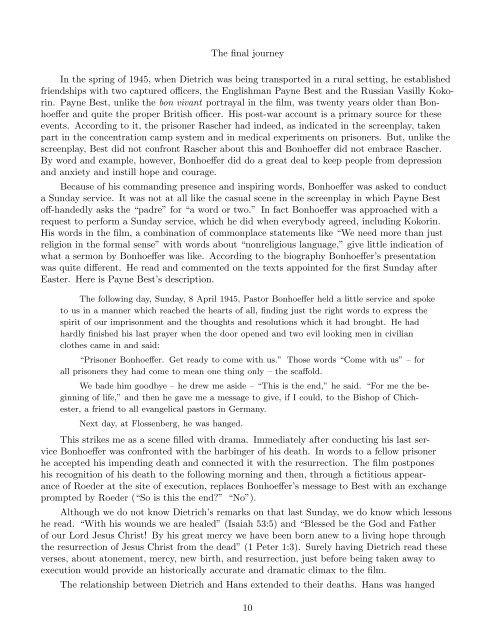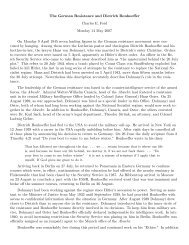Dietrich Bonhoeffer a discussion of the film Bonhoeffer: Agent of ...
Dietrich Bonhoeffer a discussion of the film Bonhoeffer: Agent of ...
Dietrich Bonhoeffer a discussion of the film Bonhoeffer: Agent of ...
You also want an ePaper? Increase the reach of your titles
YUMPU automatically turns print PDFs into web optimized ePapers that Google loves.
The final journey<br />
In <strong>the</strong> spring <strong>of</strong> 1945, when <strong>Dietrich</strong> was being transported in a rural setting, he established<br />
friendships with two captured <strong>of</strong>ficers, <strong>the</strong> Englishman Payne Best and <strong>the</strong> Russian Vasilly Kokorin.<br />
Payne Best, unlike <strong>the</strong> bon vivant portrayal in <strong>the</strong> <strong>film</strong>, was twenty years older than <strong>Bonhoeffer</strong><br />
and quite <strong>the</strong> proper British <strong>of</strong>ficer. His post-war account is a primary source for <strong>the</strong>se<br />
events. According to it, <strong>the</strong> prisoner Rascher had indeed, as indicated in <strong>the</strong> screenplay, taken<br />
part in <strong>the</strong> concentration camp system and in medical experiments on prisoners. But, unlike <strong>the</strong><br />
screenplay, Best did not confront Rascher about this and <strong>Bonhoeffer</strong> did not embrace Rascher.<br />
By word and example, however, <strong>Bonhoeffer</strong> did do a great deal to keep people from depression<br />
and anxiety and instill hope and courage.<br />
Because <strong>of</strong> his commanding presence and inspiring words, <strong>Bonhoeffer</strong> was asked to conduct<br />
a Sunday service. It was not at all like <strong>the</strong> casual scene in <strong>the</strong> screenplay in which Payne Best<br />
<strong>of</strong>f-handedly asks <strong>the</strong> “padre” for “a word or two.” In fact <strong>Bonhoeffer</strong> was approached with a<br />
request to perform a Sunday service, which he did when everybody agreed, including Kokorin.<br />
His words in <strong>the</strong> <strong>film</strong>, a combination <strong>of</strong> commonplace statements like “We need more than just<br />
religion in <strong>the</strong> formal sense” with words about “nonreligious language,” give little indication <strong>of</strong><br />
what a sermon by <strong>Bonhoeffer</strong> was like. According to <strong>the</strong> biography <strong>Bonhoeffer</strong>’s presentation<br />
was quite different. He read and commented on <strong>the</strong> texts appointed for <strong>the</strong> first Sunday after<br />
Easter. Here is Payne Best’s description.<br />
The following day, Sunday, 8 April 1945, Pastor <strong>Bonhoeffer</strong> held a little service and spoke<br />
to us in a manner which reached <strong>the</strong> hearts <strong>of</strong> all, finding just <strong>the</strong> right words to express <strong>the</strong><br />
spirit <strong>of</strong> our imprisonment and <strong>the</strong> thoughts and resolutions which it had brought. He had<br />
hardly finished his last prayer when <strong>the</strong> door opened and two evil looking men in civilian<br />
clo<strong>the</strong>s came in and said:<br />
“Prisoner <strong>Bonhoeffer</strong>. Get ready to come with us.” Those words “Come with us” – for<br />
all prisoners <strong>the</strong>y had come to mean one thing only – <strong>the</strong> scaffold.<br />
We bade him goodbye – he drew me aside – “This is <strong>the</strong> end,” he said. “For me <strong>the</strong> beginning<br />
<strong>of</strong> life,” and <strong>the</strong>n he gave me a message to give, if I could, to <strong>the</strong> Bishop <strong>of</strong> Chichester,<br />
a friend to all evangelical pastors in Germany.<br />
Next day, at Flossenberg, he was hanged.<br />
This strikes me as a scene filled with drama. Immediately after conducting his last service<br />
<strong>Bonhoeffer</strong> was confronted with <strong>the</strong> harbinger <strong>of</strong> his death. In words to a fellow prisoner<br />
he accepted his impending death and connected it with <strong>the</strong> resurrection. The <strong>film</strong> postpones<br />
his recognition <strong>of</strong> his death to <strong>the</strong> following morning and <strong>the</strong>n, through a fictitious appearance<br />
<strong>of</strong> Roeder at <strong>the</strong> site <strong>of</strong> execution, replaces <strong>Bonhoeffer</strong>’s message to Best with an exchange<br />
prompted by Roeder (“So is this <strong>the</strong> end?” “No”).<br />
Although we do not know <strong>Dietrich</strong>’s remarks on that last Sunday, we do know which lessons<br />
he read. “With his wounds we are healed” (Isaiah 53:5) and “Blessed be <strong>the</strong> God and Fa<strong>the</strong>r<br />
<strong>of</strong> our Lord Jesus Christ! By his great mercy we have been born anew to a living hope through<br />
<strong>the</strong> resurrection <strong>of</strong> Jesus Christ from <strong>the</strong> dead” (1 Peter 1:3). Surely having <strong>Dietrich</strong> read <strong>the</strong>se<br />
verses, about atonement, mercy, new birth, and resurrection, just before being taken away to<br />
execution would provide an historically accurate and dramatic climax to <strong>the</strong> <strong>film</strong>.<br />
The relationship between <strong>Dietrich</strong> and Hans extended to <strong>the</strong>ir deaths. Hans was hanged<br />
10



